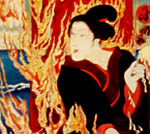|

 |
In
1986, the child of a friend contracted
HIV from a tainted blood transfusion. This event shocked Teraoka and
impelled him to turn his attention to the escalating terrors and tragedies
of the AIDS epidemic. His AIDS series, which began in 1987 and continues
today, includes some of Teraoka's most thought-provoking and best -known
works.
Raised in a family of textile designers, he was
exposed to a wide range of artistic influences from a very young age.
After studying art and aesthetics at Kwansei Gakuin University in Kobe,
Teraoka moved to the United States in 1961 and earned a BA and MFA from
the Otis Art Institute in Los Angeles.
Teraoka first began to develop his signature
fusion of Japanese ukiyo-e and American Pop Art in Los Angeles during
the early 1970s, and by the mid-1970s was exhibiting regularly in group
and solo exhibitions throughout southern California. He gained national
recognition in 1976 in group shows at the Museum of Modern Art in New
York and the Los Angeles County Museum of Art, and, in 1979, was given
a major solo exhibition at the Whitney Museum of American Art in New
York. Following the successful Whitney exhibition, Teraoka relocated
to Hawaii, where the geological location and ethnic diversity seemed
better suited to his position on the cusp between two cultures.
Over the next 15 years Teraoka produced prolifically,
and his works were shown at and collected by major museums and galleries
all over the world. In 1996, at the age of 60, he was honored with a
retrospective exhibition at the Arthur M. Sackler Gallery in Washington,
D.C.
Over the course of his long career, Teraoka's
style and range of subjects have developed and broadened considerably.
The most recent twist in Teraoka's career occurred after the artist's
trip to Europe in 1992. Inspired by the surreal imagery of the Netherlandish
painter Hieronymous Bosch and other Northern European Mannerist and
late Gothic artists, Teraoka began experimenting with a darker palette
and with more apocalyptic, visionary subjects. Although the style of
these later paintings is completely different from his early work, the
familiar themes of alienation, suffering, and violence still predominate.
Ultimately, despite the many stylistic and thematic changes Teraoka's
work has undergone through the years, its underlying confrontational
sensibility has remained a constant that unifies his entire oeuvre.
|